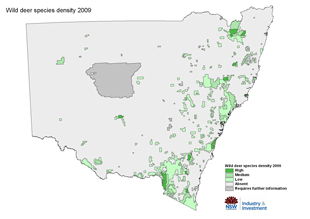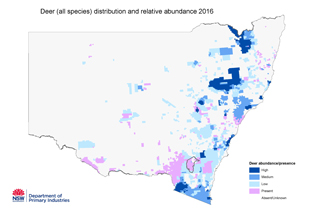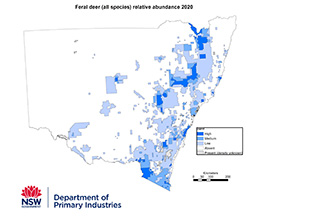
Feral Deer
There are five feral deer species that occur across a wide range of landscapes in NSW. Their populations continue to increase, causing problems in residential, agricultural and natural environments.
Deer have been introduced into the Australian environment:
- during the 19th and 20th centuries, mainly by acclimatisation societies to improve the aesthetics of the environment and to provide sport for gentry
- by accidental or deliberate release from deer farms when velvet and venison production was not profitable
- through translocation or deliberate illegal releases for hunting.
The origin of these deer species varies. Rusa, chital and sambar deer originate from South-East Asia (India, Indonesia, Sri Lanka and the Philippines), whilst red and fallow deer are from Mediterranean Europe.
Description of feral deer species in NSW

Chital deer
 V
V
View larger image (PNG, 237.28 KB)
- Antlers lyre-shaped, smooth and slender with three tines per antler.
- Brow tine often long and curved.
- Anterior or outer tine of terminal fork invariably longer than inner tine.
- Round in section.
- Coat colour rusty red to dark brown with white spots running in broken lines along flanks of body.
- A dark dorsal stripe is also prominent, and a dark band occurs over the muzzle.
- Coat colour on the belly and inside legs generally white.
- Prominent white throat latch.

Fallow deer

View larger image (PNG, 301.92 KB)
- Antlers multi-tined, upper half palmate or flattened.
- Coat colour is variable and includes: white spots (menil) over dark chocolate, lighter brown or reddish brown or white all over.
- Prominent black and white marking on tail and buttocks of darker coloured deer.

Red deer

View larger image (PNG, 258.77 KB)
- Antlers multi-tined, 6 – 8 tines common, 10 – 12 less frequent.
- Round in section.
- Coat colour is reddish in summer and greyish-brown in winter, with lighter yellow coloured rump patch prominent all year.
- Young have white spots along their flanks when first born, which tend to fade within a few months.
- Tail is small and indistinct.
- Ears are long and pointed.

Rusa deer
View larger image PNG, 264.72 KB
- Antlers in adults are lyre-like with 3 tines per antler – a single “brow” tine and a terminal forked set of tines.
- The rear tine (being the second tine from the antler base) on the forked pair is always longer than the third or outermost tine. Additional tines, normally backward and downward facing, may form off the main beam where nutrition is excellent.
- Round in section.
- Coat colour in summer is reddish-brown, darkening on the hind quarters and lightening on the chest.
- Winter coat is thicker, upper parts are greyer. Males often develop a thick mane.
- Newborns are a rich red colour.

Sambar deer

View larger image PNG, 247.34 KB
- Antlers lyre-like with 3 tines including a single brow tines and terminal forked tines. Round in section. The front tines of the forked pair can be an extension of the main antler beam and is usually longer than the rear tine.
- Coat colour is uniformly dark brown, though lighter colour on the belly and inner sides of legs.
- Large rounded ears about half the size of the head. Each ear has a white margin on the back of the ear.
- Distinctive alarm “honk” when disturbed and will raise their bushy tail over the back and flare the rump hair, running in a “crouching” gait.
Information on feral deer in NSW

Distribution
The distribution and densities of all five feral deer species is increasing across NSW. Fallow, red, sambar and rusa deer are found in many parts of NSW. Chital deer populations are isolated across parts of NSW but are expanding in range.
All species of feral deer have the potential to increase their spread and density throughout NSW. The Department periodically collects and collates data and best-available information on the distribution and relative abundance of deer species throughout NSW. Surveys are conducted through consultation with land management organisations, including the NSW National Parks and Wildlife Service and Local Land Services
See distribution maps.

Diet
All species of deer in Australia will graze or browse on a large variety of vegetation, including native shrubs, vines, trees, herbs and grasses. In urban areas, deer will eat many garden plants.

Reproduction
The gestation period of the feral deer species in Australia is around 240 days. Red and fallow deer have distinct breeding seasons while chital, rusa and sambar deer have less distinct seasons but generally give birth during the spring. Weaning occurs approximately 10 months after offspring are born. Females of chital and sambar deer have post-partum oestrus and may produce three young every two years. Most males are sexually mature at 12 months of age.

Social structure
The social structure of feral deer species in Australia falls into two broad types: solitary or gregarious (living in social groups/herds).
Sambar deer are mostly solitary but may form small groups.
| Deer species | Outside breeding season | During breeding season |
|---|---|---|
| Chital | Groups of two to three females and their young to mixed herds of over 100 deer. | Not clearly defined. |
| Red | Female groups and their offspring. Males separate from females and form bachelor groups in the winter, through to late summer. | Males become very vocal and collect groups of females and regularly wallow. |
| Fallow | Groups of females and their offspring and separate groups of bachelor males. | Dominant males establish “rutting” stands within a defined territory and attempt to attract and defend a group of females. |
| Rusa | Mostly in groups with males separate from females. | Breeding groups with dominant stag and female, with young stags in satellite groups challenging dominant males. Soft breeding peaks in June, July and August. |
| Sambar | Solitary or in small groups | During the breeding cycle adult males attract females by using an array of ‘signposts’ – including wallow, scrapes and preaching trees that are routinely scent-marked. |

Habitat
Most of the feral deer species in NSW share some common preferences for habitat. Preferences for the various deer species are:
- red and fallow deer prefer open forest and woodland with grassy understorey or in woodland edge adjacent to grassland
- sambar are often associated with tall wet eucalypt forest, are often found at the edges of farmlands, and are also known to inhabit heathland, wetland, woodland, dry forest and rainforest
- chital will inhabit areas that have mixed woodland with grassy edges, riparian thickets, woodlands and rainforest.

Impact
Feral deer impact agricultural production by:
- competing directly with livestock for resources (food, water and shelter), particularly in dry times
- disrupting grazing systems by grazing resting paddocks which leads to pasture degradation
- damaging fencing creating large holes or damaging large sections when they get entangled in wires
- damaging broadacre crops, horticulture and forestry.
Various attempts at measuring pasture consumption of deer have been carried out using the standard stocking rate measure of dry sheep equivalent (DSE). These calculations are mainly for various categories of farmed (red and fallow) deer. Average DSE values range from 1.2 for dry (non-lactating female) fallow deer to 3.5 for male red deer.
Energy requirements will vary for:
- breeding and non-breeding animals
- farmed and feral deer.
Native vegetation communities can be impacted in several ways, including:
- ringbarking and killing native plants by antler rubbing (localised impacts can be severe)
- damaging revegetation programs
- wallowing, scraping and trampling vegetation in riparian areas
- browsing and overgrazing vulnerable species such as orchids and daisies
- browsing on vegetation, reducing seedling establishment and seed production
- spreading weeds such as blackberry and honeysuckle as weed seed can remain viable after passing through the gut
- impacting water quality through erosion, wallowing and faecal contamination.
The impacts of feral deer on native animals are less obvious and can be difficult to measure, but include:
- eating all parts of plants, including flowers and seed-bearing structures, that native animals depend on
- facilitating exotic predators by creating paths in dense vegetation and providing an additional food source for exotic predators
- trampling or damaging the nest sites, dens or burrows of ground-living native animals.
Social impacts include:
- being a threat to community safety by displaying aggressive behaviour to people, livestock and pets
- damage to gardens
- cause of vehicle and train accidents
- cause of stress and emotional impact on land mangers required to continuously ground shoot animals at night to reduce impacts
- tying up significant resources on public and private land
- encourage illegal hunting and associated rural crime.

Disease spread
Feral deer have the potential to:
- spread zoonoses such as leptospirosis and cryptosporidium
- spread endemic livestock diseases making it more difficult for livestock producers to maintain effective animal biosecurity plans
- potentially increase the difficulty of managing an emergency animal disease outbreak including foot and mouth disease.
Feral deer management
Feral deer control operations require effective planning, implementation and monitoring.
In some parts of NSW feral deer are widespread and densely populated and in others – such as the north-eastern corner of NSW; deer are either generally absent or at low densities. Therefore, management objectives vary by region and by species.
Eradication of all but very isolated incursions of small numbers of deer, such as recent deer farm escapes, is generally not achievable.
Eradication relies on:
- rapid reporting and effective delimitation of the new population
- isolated populations with little or no immigration or emigration
- the rapid application of complementary and effective control techniques that do not educate deer to avoid the control technique.
Containment targets for deer populations require deer to be prevented from spreading to other areas or a prescribed zone. They require high level planning and well thought out execution.
Asset protection targets for deer in NSW vary according to the asset and the deer species. The effective reduction in deer impacts requires sustained control effort upon deer populations. Effective population level control (assuming that deer impacts increase directly with deer numbers) requires an annual reduction of between 34 and 49% of deer populations (depending on the species).
Control options

Fencing
Fencing can be effective at protecting high value agricultural or environmental assets from the impacts of deer. However, deer exclusion fencing is expensive and requires regular maintenance. A cost benefit analysis should be conducted before constructing deer exclusion fencing. A number of deer exclusion fences have been designed and normally consist of a combination of conventional and electric construction. For more information about deer fencing Using-Exclusion-Fencing-to-Manage-Feral-Deer.pdf

Aerial shooting
Aerial shooting can be an effective form of deer control in open or semi open areas. In many situations it is the most effective deer control tool available. Large numbers of deer can be controlled quickly and humanely allowing for population reductions greater than the annual rate of increase of (35-40%).

Ground shooting
Shooting of deer from the ground encompasses a broad range of activities often with different objectives. Ground shooting can be described in three categories - recreational, commercial and professional. All ground shooting of deer should be carried out in accordance with the Standard operating procedure for the ground shooting of feral deer.
On its own ground shooting of deer is rarely effective in supressing deer populations or limiting the spread of deer into new areas. In large scale control programs, the use of ground shooting should be carefully integrated with and planned to complement aerial shooting and exclusion fencing.

Trapping
Deer trapping in sometimes used in NSW to remove deer in high density urban or peri urban areas where conventional ground shooting cannot be carried out due to safety concerns. Two main types of traps have been used to trap deer in New South Wales; large coral traps and Clover traps. Deer trapping can be costly and is likely to only remove a low percentage of the population. It should only be done after careful planning and a long period of feeding to allow the deer to become comfortable with the trap. It is best suited to removing small numbers of problem animals.
More Information
NSW
National
Distribution Maps

Distribution map 2009

Distribution map 2016

Distribution map 2020

Distribution map 2016 - 2020

Distribution maps 2023
All deer distribution map 2023
Click map for larger view (PNG, 50.2 KB)
Chital deer distribution map 2023
Click map for larger view (PNG, 37.58 KB)
Fallow deer distribution map 2023
Click map for larger view (PNG, 57.08 KB)
Red deer distribution map 2023
Click map for larger view (PNG, 40.97 KB)
Rusa deer distribution map 2023
Click map for larger view (PNG, 36.49 KB)






